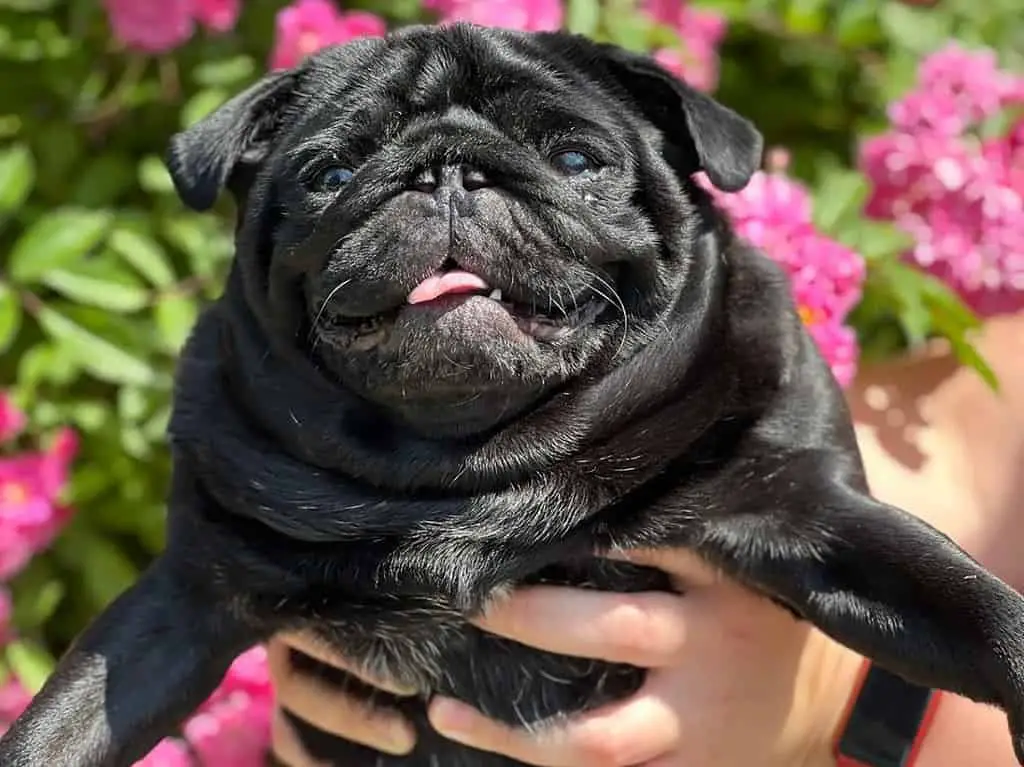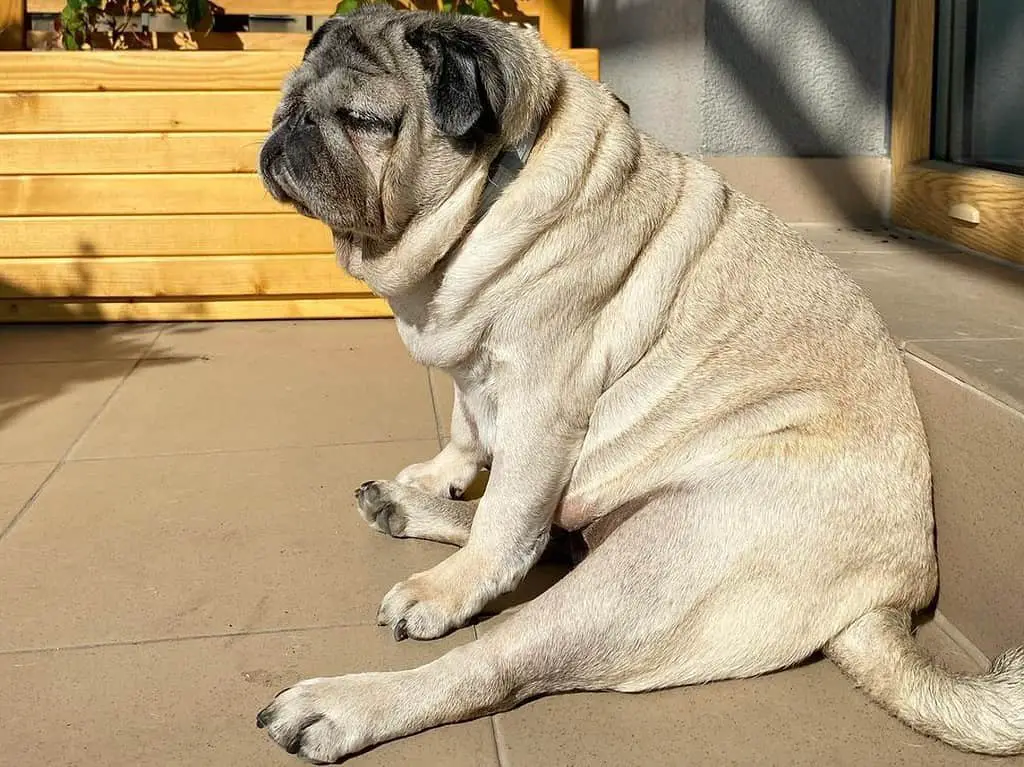Pugs are an incredibly popular breed, renowned for their adorable features and cheerful dispositions. Nevertheless, as responsible pet owners, it’s crucial to address an essential aspect of Pug care: their weight. We should remain conscious of the pup’s well-being and ensure they maintain a suitable amount of weight. With that in mind, how much should a Pug weigh?
Determining the proper weight range for a Pug can be difficult since the size depends on multiple variables, including age, sex, body structure, and more. This article provides general guidelines that allow owners to assess if their Pug is at an acceptable weight level and tips to help them maintain optimal weight for a given age and size.

Pug Breed Overview
Pugs are characterized by their distinctive round heads, deep facial wrinkles, and large dark eyes. They have a compact body structure complemented by their tails which tuck up over the hindquarters. This breed’s short snout is a clearly visible feature, giving them a relatively flat-faced look. The coats of these dogs range in color from fawn to black to white and are usually short and smooth.
Pugs are well-known for their cheerful, outgoing personalities. They tend to take on a lighthearted, comical demeanor due to their lively nature, which can bring joy into the home. This breed requires plenty of companionship from humans to be contented, preferring to stay the focus of attention. Due to their flexible dispositions, they can easily settle into different living spaces ranging from small apartments to spacious homes.
They are well-suited to family life, as they interact positively with children and other animals. Characteristically loving and devoted to their owners, these small dogs need to be kept active to prevent obesity because they lack the natural energy of larger breeds. And o fulfill exercise demands, regular short walks and interactive play are mandatory.
Pugs are relatively undemanding regarding care; short snouts make them vulnerable to respiratory problems, overheating, and excessive snoring. Furthermore, they are prone to corneal ulcers, proptosis, and dry eye with require attentive care.
How Much Should A Pug Weigh
Weight discrepancies among Pug dogs are common and determined by age, sex, genetics, body structure, and overall health. Nonetheless, there are established indicative weight ranges for the breed in general.
Generally, adult male Pugs are expected to weigh between 14 and 18 pounds per breed standards. In contrast, adult female Pugs should typically have body weights ranging from 13 to 16 pounds. These measurements are deemed healthy and ideal.
Factors Affecting Weight In Pugs
Genetics
One crucial factor is genetics. The genetic makeup of a Pug is largely influenced by the genes it receives from its parents. If the sire and dam are on the smaller side, their litter will likely inherit that trait. On the other hand, if either parent is larger, their puppies may be expected to reflect this in weight or build.
Diet and Nutrition
Monitor the dietary habits of Pugs due to their hereditary vulnerability to putting on weight. Making sure that they are provided with a nutritious and balanced diet can help maintain their health.
Impose strict limitations on the amount of food a Pug consumes. Due to their small size and lower metabolic rate than larger breeds, they only need fewer calories for good health. An excessive food intake will result in weight gain, adversely affecting their well-being; therefore, measure food portions.
Observe moderation when feeding treats or snacks to Pugs, as they are known for putting on the charm and having difficulty turning down food. Consuming excessive treats and snacks high in calories can lead to weight gain in Pugs. Consequently, it is advisable to opt for low-calorie options with healthy ingredients or use alternative rewards, such as praise or playtime, instead of relying solely on food items.

Additionally, the type and amount of food consumed are essential in regulating the weight of Pugs. Their diet must include nutrient-rich ingredients such as lean proteins, complex carbohydrates, and healthy fats to guarantee they receive all necessary nutrients while avoiding unnecessary weight gain. Care should be taken to eliminate excess fillers, artificial additives, or empty calories from their meals.
It is worth mentioning that the dietary requirements of Pugs can vary significantly and may influence their weight. Due to this, certain dogs may benefit from specially-made diets that contain fewer calories and fat than regular nutrition. These developed meals not only provide all the necessary nutrients but also help to limit calorie intake. Consulting a veterinary professional is highly recommended to meet the individual needs of any Pug, such as age, activity level, and health considerations.
Activity Level
Pugs are a brachycephalic breed, possessing short snouts and body builds that are naturally small. As a result of this anatomy, they have a heightened likelihood of developing respiratory issues and struggle to engage in strenuous physical activity. Although their abilities may be more restricted than other breeds, it is still essential to offer regular exercise specifically catered to the needs of Pugs.
Considering Pug breed characteristics, appropriate physical activity helps keep them at a healthy weight and supports general well-being. Due to difficulties in breathing experienced by Pugs resulting from their flattened snouts, moderate activities which incorporate regular walks, light recreational playing, and mentally engaging indoor games are advised as they provide fitness benefits without putting substantial pressure on the respiratory system.
An unhealthy lifestyle that does not include physical activity can result in weight gain for Pugs. Metabolism slows down when they do not exercise; therefore, smaller amounts of food can contribute to excess weight. This can have dire consequences, including negative impacts on respiratory functions and a greater risk of joint problems, heart diseases, diabetes, and other health complications.
Age
Pugs are generally small when puppies, yet they gain weight quickly to reach their full adult size within the first year or two. As the Pug ages, typically into its senior years, it may experience changes in body composition and weight fluctuations.
During the early stages of adulthood, Pugs generally maintain a stable weight range if given appropriate nutrition and exercise. This can lead to optimal bodily function and aid in preventing any health concerns that arise from obesity. Consequently, ensuring they are well-fed and active during these years may benefit their overall physical condition.
As the years’ progress, Pugs may experience age-related changes that impact their weight. Metabolism tends to become slower with age, resulting in a decreased burning of calories; this can lead to an increased body mass index if they maintain identical caloric intake and reduce physical activity levels. Furthermore, elderly Pugs may suffer from decreased muscle mass and bone density, which could contribute to further weight changes.
It is also worth noting that health issues may lead to changes in weight. Senior Pugs are more vulnerable to medical concerns such as arthritis, which cause them difficulty with movement and hence a reduction of physical activity. When exercise levels drop, an increase in weight is likely, along with decreased overall wellness.
Body Structure
Due to their solid, muscular frames, Pugs are often prone to bearing excess weight. This can lead to complications, such as joint stress from obesity or arthritis, due to the added pressure on their bones and muscles.
As Pugs age, their bodies naturally form into a round structure susceptible to excessive weight gain. With wide chests and relatively short legs, even small increases in body mass can be visible; such weight gain can critically affect a Pug’s physical health.
Another physical attribute to consider in relation to Pug anatomy is the type of facial structure they possess. Pugs have a distinctively short, furrowed face with a flattened snout and pushed-in muzzle known as brachycephaly. Unfortunately, this facial characteristic can result in reduced lung capacity and inhibited ability to partake in strenuous exercise or bodily activity. Therefore, the metabolic rate among Pugs tends to be lower than other breeds, leaving them more prone to weight gain that may prove difficult for them to lose afterward.
Underlying Health Conditions
One condition that can impact the body mass of Pugs is hypothyroidism. This endocrine disorder arises from insufficient thyroid hormone production by the thyroid gland. Hypothyroidism can cause a Pug’s metabolism to decrease, resulting in an increase in weight and difficulty losing the additional pounds. The dog’s desire to eat may not be diminished; however, their metabolic rate tends to slow down, making it more complicated for them to lose excess weight.
Another health condition that can impact a Pug’s weight is Cushing’s disease. This condition occurs when an excessive amount of cortisol, a stress hormone, is created by the adrenal glands. Dogs with Cushing’s disease can experience heightened hunger levels and thus consume more than usual amounts of food, causing them to become overweight. Furthermore, body fat can be shifted around in Viewers with this issue, thereby creating a heavy abdomen.
Respiratory issues, including brachycephalic airway syndrome, are prevalent in Pugs. This disorder impedes their ability to breathe oxygen properly, significantly decreasing their capacity for exerting activity. The decreased physical movement associated with the condition can be conducive to unhealthy weight gain and obesity. For these reasons, it is challenging for Pugs who suffer from respiratory conditions to engage in normal exercise routines, though these exercises are essential for preserving a healthy weight.
Furthermore, allergies and food intolerances can adversely affect the weight of a Pug. In these cases, they may have sensitivities to certain elements within their diet, causing gastrointestinal issues and issues with their weight. Allergic reactions involve inflammation, thus disrupting the metabolism and consequently decreasing nutrient absorption, potentially leading to an increase or decrease in weight.
Read also: Is My Pug Underweight? Is It Bad and How to Tell
Neutering/Spaying
The surgical sterilization of pets, known as neutering or spaying, may contribute to weight fluctuation in Pugs. It is important to consider all possible influences on the animal’s body weight when examining the effects of such procedures.
Neutering or spaying a Pug is associated with a significant decrease in the production of hormones such as estrogen and testosterone. These endocrine agents are responsible for regulating metabolism and body weight maintenance. With the organs controlling their secretion removed, this brachycephalic breed loses this metabolic control – reducing its capacity to burn calories, resulting in significant weight gain over time.
Another aspect to consider is the Pug’s level of activity post-neutering or spaying. Hormonal changes may alter the dog’s energy levels and cause them to be less active, decreasing their motivation to perform physical activities. Without proper exercise, they may have issues with weight gain as they are not burning as many calories as pre-procedure.
Following neutering or spaying, changes in a Pug’s dietary habits may occur; some dogs may experience an increase in appetite, while others may show a decrease. It is, therefore, important for owners to be aware of any changes and modify their diet as necessary to ensure that their pet does not overindulge or consume inadequate amounts of nutrients. Establishing a suitable meal plan with adequately monitored portions can help maintain optimal weight post-operation.
Changes in hormones caused by neutering or spaying may impact the weight of a Pug. While individual genetic markers can influence their capacity to gain weight, it is essential to consider each dog’s distinct characteristics and requirements when evaluating how spaying or neutering will affect its size.
How To Keep Your Pug At A Healthy Weight
You may already know that Pugs are notoriously known for their enthusiasm towards food; Pugs frequently become overweight if the appropriate diet and exercise are not implemented. Therefore, it is imperative to encourage moderation in both cases.
Consult a veterinarian to accurately determine the ideal amount of food suitable for your pug’s age, size, and activity level. Free feeding is not advised as it could lead to excessive eating. Create an effective feeding routine and make sure portion sizes are exact to promote proper health habits. To sustain a healthy lifestyle, select high-quality dog food specifically designed for small breeds, considering any dietary restrictions or existing medical conditions affecting your pet.
Do not only control the size of portions when feeding a Pug but also ensure that their diet is nutritionally balanced and provides them with needed nutrition without an overabundance of calories. Refrain from giving them table scraps or treats with excessive calories; opt for low-calorie snacks such as carrots or apples, which can be used during training sessions.
Incorporate regular exercise in your Pug’s daily routine to ensure that it maintains its weight. Although pugs may not be naturally active, they require moderate exercise, such as walking or engaging in interactive play for at least 20 minutes daily. Care should be taken to consider any respiratory issues associated with their short snouts and avoid strenuous exercises that could result in difficulty breathing.
Additionally, closely monitoring the weight of your Pug is essential to recognizing any abnormal gains in weight or potential obesity. Weigh your Pug routinely at home or during vet appointments and document any changes. If you observe excessive weight gain, speak with a veterinarian immediately so they can adjust their diet plan and exercise routine accordingly.
Remember that maintaining a healthy weight for your Pug concerns visual aspects and directly affects their health and lifespan. Thus, it is essential to create an appropriate dietary plan with reasonable portions, regular physical activity, and regular monitoring of weight changes. Following these steps could ensure your beloved companion’s active and fulfilled life.




